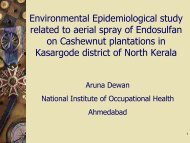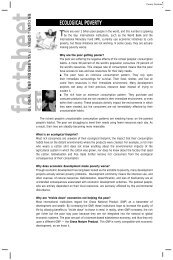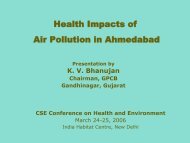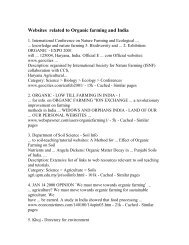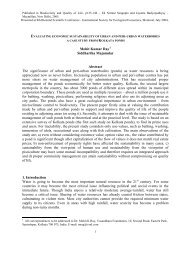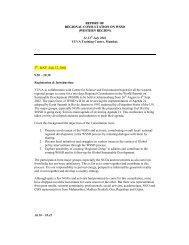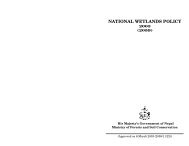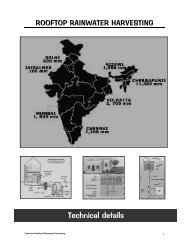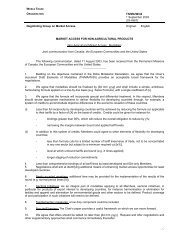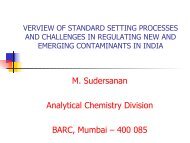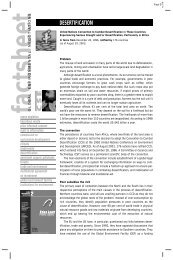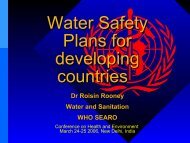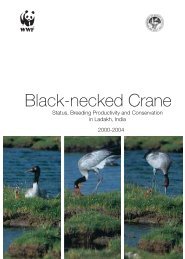Reviving a Water Heritage: - Rainwater Harvesting
Reviving a Water Heritage: - Rainwater Harvesting
Reviving a Water Heritage: - Rainwater Harvesting
Create successful ePaper yourself
Turn your PDF publications into a flip-book with our unique Google optimized e-Paper software.
Particulars<br />
Madhya Pradesh Rajasthan Gujarat<br />
Dhababavdi Temla Nagana Godavas Tera Reha Mota<br />
WTP TWHS 26.8 11.8 14.3 4.7 77.3 11.8<br />
WTP PIPE 22.0 9.8 5.7 - 18.2 7.8<br />
WTP O&MTWHS 39.0 76.5 97.1 100.0 93.2 90.2<br />
WTP O&MPIPE 29.3 13.7 17.1 - 72.7 13.7<br />
WTP LABOURTWHS 92.7 84.3 97.1 100.0 77.3 74.5<br />
An important aspect of this exercise in assessing WTP is that even the most sophisticated<br />
methods of valuation may be inadequate to elicit information on the WTP behaviour if the<br />
respondents refuse to participate in the `bidding’ process due mainly to abject poverty and<br />
rejecting the very proposal that potable water could be priced for the rural poor.<br />
Recommendations<br />
A number of technological options to revive/ modernize the TWHS have been put forth by the<br />
hydro geological and engineering experts. Most of the considered suggestions have been<br />
highly discrete (specific to the system or site per se) and often have incorporated ideas from<br />
local inhabitants. For instance, as may be seen from Table 3, especially the bavdis may not<br />
prove to be adequate sources of water due to their small size. Table 3 presents brief notes<br />
on suggested technological interventions, which may serve as useful guidelines in<br />
appreciating the utility and sustainability of individual systems.<br />
Table 3: Structural Issues Relating to the Revival of TWHS<br />
Particulars<br />
Structural<br />
Features<br />
Potability<br />
Technological<br />
Interventions<br />
Bavdi Well Talav<br />
Dhababavdi Temla Nagana Godavas Tera Reha Mota<br />
Structure is<br />
Huge<br />
small<br />
capacity and<br />
favourable<br />
Unsuitable<br />
for human<br />
drinking<br />
Desilting of<br />
catchments<br />
would<br />
improve<br />
water table<br />
<strong>Water</strong><br />
unsuitable for<br />
human<br />
drinking<br />
Desilting of<br />
local talav is<br />
essential for<br />
recharge of<br />
the bavdi<br />
Ground<br />
water is<br />
becoming<br />
saline<br />
Desilting of<br />
local talav<br />
would<br />
improve the<br />
water and<br />
reduce<br />
salinity<br />
Increasing<br />
salinity<br />
topography<br />
Used as<br />
potable water<br />
Some people<br />
reported to<br />
have had<br />
diseases<br />
because of<br />
the bacterial<br />
contaminatio<br />
n of the<br />
water during<br />
late summers<br />
Reported to be<br />
unsuitable for<br />
drinking but<br />
good for<br />
cooking<br />
Desilting would<br />
improve the<br />
groundwater<br />
level in the<br />
area<br />
Table 4 presents some relevant issues covering management and maintenance of the TWHS.<br />
In case of the well in Nagana in Rajasthan and the talav in Tera in Gujarat the local<br />
community did management and maintenance of the TWHS. These are the villages where the<br />
use of water from TWHS has been extensive and also the quality of water has been well<br />
maintained. In the remaining cases, a preference has been expressed for complete or partial<br />
involvement of state government in managing and maintaining the sources. In these villages,<br />
the general lack of confidence in the efficacy of the sarpanchs in managing these sources is<br />
v



